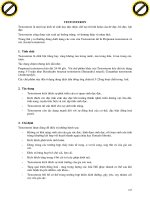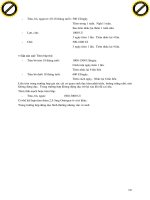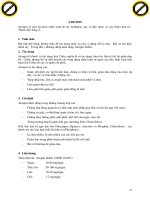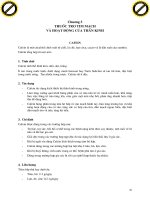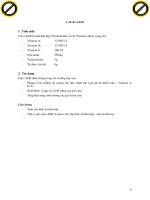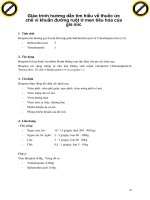THUỐC ỨC CHẾ ACID CẠNH TRANH KALI (Potassiumcompetitive acid blocker_ PCAP)
Bạn đang xem bản rút gọn của tài liệu. Xem và tải ngay bản đầy đủ của tài liệu tại đây (2.38 MB, 24 trang )
ĐÔI ĐIỀU VỀ
THUỐC Ứ CHẾ ACID CẠNH TRANH KALI
(Potassium-competitive acid blocker_ P-CAP)
Bs. Lê Đình Tín
Phịng Khám Tiêu Hóa – Gan Mật
Người bệnh nhiễm vi khuẩn H.Pylori có thêm phương pháp chữa trị
12-05-2022 10:21 AM | Thuốc mới
SKĐS- Nếu không được điều trị, nhiễm vi khuẩn H. Pylori có thể dẫn đến các biến chứng
nghiêm trọng, chẳng hạn như bệnh loét dạ dày tá tràng và ung thư dạ dày… FDA vừa phê duyệt
hai sản phẩm có chứa vonoprazan để điều trị nhiễm vi khuẩn H. Pylori ở người lớn…
Theo đó hai sản phẩm được phê duyệt là:
Voquezna Triple Pak là một sản phẩm đóng gói chung có chứa vonoprazan, amoxicillin một loại kháng sinh nhóm penicillin và clarithromycin - một chất kháng khuẩn macrolide.
Voquezna Dual Pak là một sản phẩm đóng gói chung có chứa vonoprazan và amoxicillin.
… Vonoprazan là một thuốc ức chế acid cạnh tranh kali, có tác dụng ức chế bơm proton ở
tế bào thành dạ dày, từ đó ức chế bước cuối cùng trong bài tiết acid vào dịch vị …
/>
Proton pump inhibitors (PPIs) have often been used for acid-related diseases including gastroesophageal
reflux disease (GERD), gastric and duodenal ulcers, non-steroidal anti-inflammatory drug (NSAID)-associated
ulcers, and Helicobacter pylori eradication therapy. Although PPIs have been used for more than a quartercentury as a first-line treatment for these diseases, it has become clear that there are some issues in need of
improvement.
First, it takes several days to show maximal effect. Reflux symptoms of GERD are not sufficiently
relieved after the first dose of PPIs in two-thirds of patients because of its slow onset of the action, and
one-half of patients still have symptoms even after 3 days of treatment.
Second, the effects of PPIs are influenced by cytochrome P450 (CYP) 2C19 polymorphism.
Third, its effects at night are not satisfactory.
Finally, although it requires an acidic environment for activation, PPIs are unstable in acidic
conditions, so enteric coating is needed.
To overcome the aforementioned unmet needs, alternative formulations of conventional PPIs and new H+,
+
K -ATPase inhibitors have been established. With these efforts, vonoprazan, a potassium-competitive acid
blocker (P-CAB), was developed.
Vonoprazan (Takecab) was released to the market in Japan in February 2015.
/>
3
P-CABs, which have reached human testing:
/>
4
/>
5
Background: Zastaprazan (JP-1366) is a novel potassium-competitive acid blocker with favourable
preclinical safety and efficacy profile being developed for the treatment of acid-related diseases.
Aims: To investigate the safety, tolerability, pharmacodynamics and pharmacokinetics of
zastaprazan.
Methods: A randomised, open-label, placebo- and active-controlled, single and multiple ascending
dose clinical trial was conducted in healthy Korean male subjects. Intragatric pH and serum gastrin
were measured to assess the pharmacodynamics, while serial blood and urine samples were
collected to assess the pharmacokinetics. Pharmacogenomic evaluation was conducted to explore
genetic variants, which can affect the pharmacodynamics and pharmacokinetics. Safety and
tolerability including hepatotoxicity were evaluated.
Conclusions: Zastaprazan was safe and well tolerated after a single oral dose up to 60 mg and
multiple oral doses up to 40 mg. It also showed rapid, potent suppression of gastric acid secretion.
Pharmacodynamic and pharmacokinetic profile of zastaprazan was suitable for treatment of patients
/>with acid-related diseases.
6
Comparison of Potassium-Competitive Acid Blocker (P-CAB) and Proton Pump Inhibitor (PPI) Drug Classes
/>
7
Potassium-Competitive Acid Blocker Indications and Approvals:
/>
8
/>
9
/>
10
/>
11
/>
12
Background & Aims
For decades, proton pump inhibitors (PPIs) have been the mainstay of treatment for erosive esophagitis. The
potassium-competitive acid blocker vonoprazan provides more potent acid inhibition than PPIs, but data on its
efficacy for erosive esophagitis are limited.
Methods
Adults with erosive esophagitis were randomized to once-daily vonoprazan, 20 mg, or lansoprazole, 30 mg, for
up to 8 weeks. Patients with healing were rerandomized to once-daily vonoprazan, 10 mg, vonoprazan, 20 mg,
or lansoprazole, 15 mg, for 24 weeks. Primary end points, percentage with healing by week 8 endoscopy, and
maintenance of healing at week 24 endoscopy, were assessed in noninferiority comparisons (noninferiority
margins, 10%), with superiority analyses prespecified if noninferiority was demonstrated. Analyses of primary
and secondary end points were performed using fixed-sequence testing procedures.
/>
13
Results
Among 1024 patients in the healing phase, vonoprazan was noninferior to lansoprazole in the primary analysis
and superior on the exploratory analysis of healing (92.9 vs 84.6%; difference, 8.3%; 95% confidence interval
[CI], 4.5%–12.2%). Secondary analyses showed vonoprazan was noninferior in heartburn-free days (difference,
2.7%; 95% CI, −1.6% to 7.0%), and superior in healing Los Angeles Classification Grade C/D esophagitis at
week 2 (difference, 17.6%; 95% CI, 7.4%–27.4%). Among 878 patients in the maintenance phase, vonoprazan
was noninferior to lansoprazole in the primary analysis and superior on the secondary analysis of maintenance
of healing (20 mg vs lansoprazole: difference, 8.7%; 95% CI, 1.8%–15.5%; 10 mg vs lansoprazole: difference,
7.2%; 95% CI, 0.2%–14.1%) and secondary analysis of maintenance of healing Grade C/D esophagitis (20 mg
vs lansoprazole: difference, 15.7%; 95% CI, 2.5%–28.4%; 10 mg vs lansoprazole: difference, 13.3%; 95% CI,
0.02%–26.1%).
Conclusions
Vonoprazan was noninferior and superior to the PPI lansoprazole in healing and maintenance of healing of
erosive esophagitis. This benefit was seen predominantly in more severe erosive esophagitis. (ClinicalTrials.gov:
NCT04124926).
/>
14
Received 29 April 2022 Accepted 21 June 2022 Published Online First 9 August
2022
Statement 9: Potassium-competitive acid blockers (P-CAB)—antimicrobial
combination treatments are superior, or not inferior, to conventional PPIbased triple therapies for first-line and second-line treatment, and superior in
patients with evidence of antimicrobial resistant infections.
Agreement 100%
Grade B2
B: Moderate quality; 2: Weak recommendation
/>
15
Algorithm for empirical Helicobacter
pylori eradication if individual
antibiotic susceptibility testing is not
available.
Bismuth quadruple: proton pump
inhibitor (PPI), bismuth, tetracycline
and metronidazole.
Non-bismuth quadruple (concomitant):
PPI, clarithromycin, amoxicillin and
metronidazole.
Levofloxacin quadruple: PPI,
levofloxacin, amoxicillin and bismuth.
Levofloxacin triple: the same but
without bismuth.
In cases of high fluoroquinolone
resistance (>15%), the combination of
bismuth with other antibiotics, highdose PPI-amoxicillin dual or rifabutin,
may be an option.
*High-dose PPI or P-CAB (vonoprazan
where available) plus amoxicillin may
be another option. (P-CAB, potassiumcompetitive acid blocker; PPI, proton
pump inhibitor).
/>
16
Background and Aims
Effective acid suppression is a crucial component of Helicobacter pylori (H. pylori) eradication regimens.
Approved treatments include dual, triple, and quadruple therapies composed of certain antibiotics in
combination with proton pump inhibitors (PPIs). Vonoprazan, a potassium-competitive acid blocker, provides
more potent and durable acid suppression than PPIs. We compared the efficacy of vonoprazan-based
therapies vs approved standard regimens using new evidence from the phase 3 pHalconHP trial in North
America and Europe.
Methods
Studies reporting first-line H. pylori eradication rates from empiric treatment with Food and Drug
Administration–approved therapies and vonoprazan-containing therapies were identified via bibliographic
searches of systematic literature reviews and a subsequent MEDLINE/Embase search using index terms
for H. pylori and eradication. Randomized controlled trials comparing 2 or more relevant comparators were
included in Bayesian network meta-analyses for grouped and distinct therapies.
/>
17
Results
Twenty-three distinct regimens from 42 trials including 12,773 patients were identified. Vonoprazan-based
triple therapy showed the highest relative efficacy (odds ratio: 2.73, 95% credible interval 2.11, 3.54) and
72.1% probability of being the best. North American, Western, and global scenarios were largely consistent.
Vonoprazan-based therapies demonstrated higher odds of H. pylori eradication than each PPI-based triple
therapy. Furthermore, vonoprazan-based triple therapy was superior to bismuth subcitrate quadruple therapy
(odds ratio: 1.60, 95% credible interval: 1.07, 2.38).
Conclusion
Vonoprazan-based eradication regimens represent novel treatments for H. pylori infection on a global scale,
offering efficacy that, in this analysis, is superior to PPI-based triple therapy and comparable or better than
bismuth quadruple therapy.
/>
18
Background: Three days of high-dose intravenous (IV) proton-pump inhibitor (PPI) following endoscopic hemostasis of high-risk peptic ulcer bleeding has been a standard recommendation to
prevent rebleeding. However, hospitalization is required for drug administration. The higher potency of acid-suppressive medication, a potassium-competitive acid blocker- Vonoprazan, is a
tantalized alternative given its oral preparation and potency. Nonetheless, the effect of Vonoprazan on peptic ulcer rebleeding prevention is yet to be explored.
Objective: This study aimed to compare the efficacy of Vonoprazan and high-dose IV PPI in preventing high-risk peptic ulcer rebleeding after successful endoscopic hemostasis.
Methods: This is a randomized, open-label, multicenter, non-inferiority trial. Patients with high-risk stigmata peptic ulcer bleeding, defined as Forrest classification Ia, Ib, IIa, and IIb, were
recruited from 6 secondary- and tertiary-care centers. After completion of endoscopic hemostasis, participants were randomized 1:1 to receive either Vonoprazan (20 mg twice daily orally for
3 days, then 20 mg once daily for 28 days) or PPI (pantoprazole 80 mg IV bolus followed by an 8 mg per hour infusion over 72 hours, then omeprazole 20 mg twice daily for 28 days). The
primary outcome was rebleeding within 30 days. Secondary outcomes, including rebleeding within 3 and 7 days, all causes and bleeding-related mortality within 30 days, rate of rescue therapy,
blood transfusion, length of hospital stay, and safety, were collected.
/>
19
Results: 174 patients were recruited, and 166 completed the study. Demographic data, including; age, gender, comorbidity, antithrombotic usage, clinical presentations, the severity of bleeding,
endoscopic characteristics, and stage of ulcers, were comparable among the two groups. In the intention-to-treat (ITT) analysis, the rates of 30-day rebleeding in Vonoprazan and PPI groups
were 4.5 % (4/88) and 9.3% (8/86), respectively; non-inferiority (within the margin of 10%) of Vonoprazan to PPI was confirmed (risk difference = -4.76; 95% CI = -12.28, 2.77; P =
0.0005). The rebleeding rate at days 3 and 7 of the Vonoprazan group remained non-inferior to the PPI groups (P = 0.0001 and P = 0.0006, respectively). Total blood transfusion and postendoscopy blood transfusion were lower in the Vonoprazan group [differences of -0.80 unit (95%CI = 0.03-1.56), p=0.042 and -0.56 unit (95%CI = 0.04-1.09), p=0.034, respectively]. The allcause mortality rate, bleeding-related mortality rate, rescue therapy rate, length of hospital stays, and adverse events were comparable between the two groups.
Conclusion: Vonoprazan was not inferior to PPI in preventing rebleeding within 30 days in patients with high-risk peptic ulcer bleeding after receiving endoscopic hemostasis.
/>
20
Voquezna Dual Pak prices
Oral Kit
Voquezna Triple Pak prices
Oral Kit
và />
21
Kết luận
Nhóm Thuốc ức chế cạnh tranh Kali là một vũ khí đầy tiềm năng, có nhiều
ưu điểm hơn và có thể thay thế các Thuốc ức chế bơm Proton để làm giảm tình
trạng tăng tiết acid của dạ dày giúp điều trị hiệu quả nhiều bệnh lý có liên quan.
22
Tài liệu tham khảo
/>
/>
/>
/>
/>
/>
/>
/>
/>
/>
/>
23
Cảm ơn sự chú ý lắng nghe của quý vị.
24
